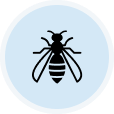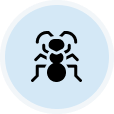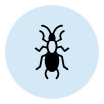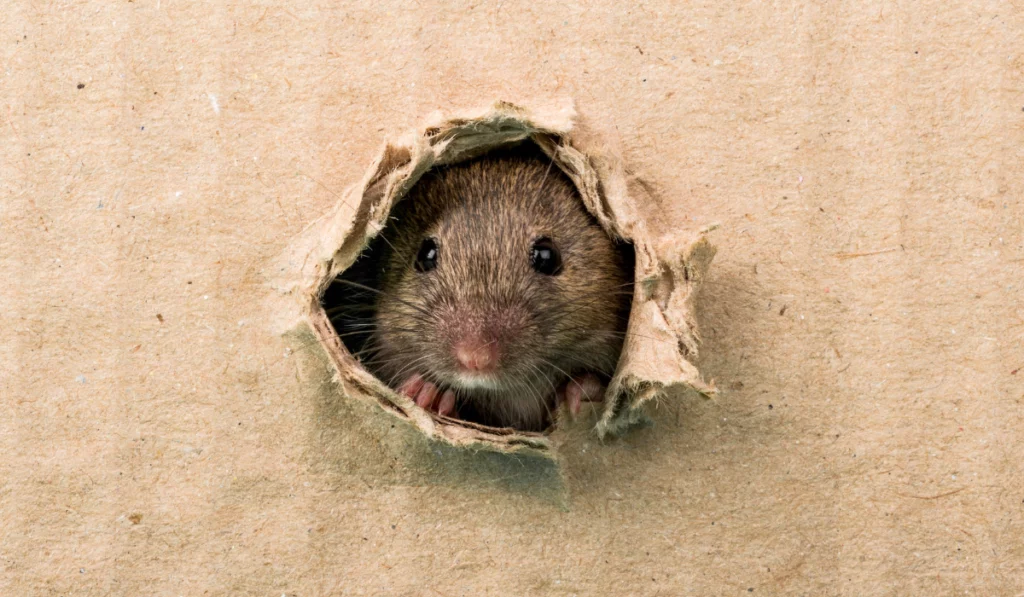Beyond keeping your pet up-to-date on their tick and flea prevention options, you might not give much thought to the humble flea. But this tiny pest brings potentially massive consequences to the hosts it infests.
With hundreds of species of fleas in the U.S. and thousands worldwide, homeowners are up against a growing threat of flea infestations. Luckily, we have the tips and resources you need to lower the number of fleas you deal with in your home.
Key Takeaways
- Fleas are small pests that feed on human and animal blood to reproduce and survive.
- While they usually bite cats and dogs, fleas can also bite humans and appear in pet-free homes.
- Signs of flea infestations include noticeable bites, flea dirt, excessive itching, and unusual behavior in pets.
- Spotting the signs of a flea takeover quickly can help you eliminate them from your home. Severe infestations usually require professional intervention to fully address.
– – –
Get flea control in Sacramento County or San Diego County
Flea infestations will not go away on their own
Contact Us Now To Get Rid Of Them
– – –
What Are Fleas?
Fleas are tiny insects that feed on animal or human blood to survive. Like other small pests, such as bed bugs, fleas rely on a host’s blood to get the nutrients they need to reproduce. There are hundreds of flea species living in the United States, but the most common include the:
- Cat flea
- Dog flea
- Squirrel flea
- Rat flea

A magnified left lateral view of a male rat flea. Source: Unsplash
What separates fleas from other household pests is their flexible diet; fleas bite pets and people. They can also carry diseases and transmit tapeworms or bacterial infections, meaning a flea infestation can be a serious health and safety risk. For this reason, fleas are commonly known as “vectors,” or organisms that transfer diseases from one animal to another.
The most common flea-borne illnesses in the U.S. include:
- The Bubonic plague: Just as fleas on rats caused the plague infestation that triggered the Black Death, modern fleas continue to carry and spread the disease. But the few plague cases that do occur are usually contained in sparsely-populated, rural areas.
- Flea-borne typhus
- Cat scratch disease (CSD)
- Flea-borne parasites like tapeworms
While most fleas prefer to take hostage in dog or cat fur, some appear in homes without animals. Flea problems can happen to anyone, not just pet owners, so knowing what warning signs to look out for is helpful.
What Is the Life Cycle of Fleas?
Life for the average flea starts in the larvae phase. Once flea eggs hatch, they become worm-like larvae hiding in protected crevices like carpet fibers. The flea larvae get the blood they need to grow by eating the feces of adult fleas. The soon-to-be fleas then transform into pupae and create a silky cocoon, where they remain for one to four weeks.
The fleas quickly seek a blood meal once they emerge from the pupal stage. Adult fleas are ravenous little fiends who consume up to 15 times their body weight in blood daily. Once they find a host to hop on board, they begin to feed in earnest, mating and laying their eggs within just 24 hours. As the eggs fall off the fur of the affected animal, the cycle repeats, and a new generation of fleas is born.
– – –
Get flea control in Sacramento County or San Diego County
Flea infestations will not go away on their own
Contact Us Now To Get Rid Of Them
– – –
Where Do Fleas Come From?
Fleas can come from outdoors or indoors, and their minuscule size makes it easy for them to hide in protective spaces. Their little hind legs can propel them to impressive heights; most fleas can jump up to six inches into the air. Once a viable host passes the flea, the pest usually launches itself onto a human or animal’s legs, shoes, or hair.
Pets may also catch fleas from spaces with lots of furry friends, such as kennels or groomers. Stray animals and wildlife, especially opossums and raccoons, can also be the culprit behind a flea infestation.
How Do Fleas Spread?
It’s commonly believed that fleas can hop from one animal to another, but this rarely happens. Instead, fleas are usually spread by coming into contact with an animal or human from carpet fibers, trees, greenery, etc.
Fleas are more likely to spread their eggs to these areas and create new adult fleas that infect more animals than they are to hitch a ride on a new host.
What Are the Signs of a Flea Infestation?
It’s important to spot and respond to the signs of a flea infestation as quickly as you can. These clever pests can attack your home from multiple angles. Look out for classic signs like these to determine whether a flea infestation might be brewing in your home:
- Visible Fleas or Flea Bites: Seeing small, fast-moving bugs in your pet’s fur, on pet bedding, carpets, or elsewhere in your home is a telltale sign you might have a flea infestation. You may also notice flea dirt, which resembles bits of ground black pepper, made up of digested blood and flea feces. Additionally, seeing tiny red bumps (flea bites) surrounded by a halo likely means it’s time to implement some pest control strategies.
- Scratching and Irritation: Flea bites can cause allergic reactions and irritate the skin. You might see them appear in clusters or lines, and they’ll likely itch quite a bit. In some cases, severe redness, swelling, and itching might warrant medical attention.
- Flea Eggs: If you spot little white specks in your carpet, furniture, or on your pet, you may be looking at a group of flea eggs. They can be hard to see with the naked eye, but combined with other signs of an infestation, eggs indicate it’s time to take action.
- Unusual Pet Behavior: Pets bitten by fleas might seem agitated or restless. They may also persistently itch or groom themselves, even to the point of self-injury. More severe signs of infestation might include signs of tapeworm larvae growing in your pet’s body or anemia, which manifests as pale gums, caused by the loss of blood from bites.
What Do Flea Bites Look Like?
Most flea bites look like small, discolored bumps, but some might become red, swollen, and itchy. They often appear in clusters, lines, or patterns around the body, most commonly on the legs, feet, and ankles. Sometimes, a discolored halo forms around the bite. Other times, a person might show no reaction to flea bites at all.
While flea bites usually don’t cause serious harm, they can certainly be annoying. And since fleas can carry diseases, it’s important to take flea bites seriously.
Where to Look for Fleas
Fleas can be found year-round but are generally most active during warmer months. You can find them outside in shady areas and cool, damp spots with lots of hiding spots. Trees, leaves, tall grass, and shrubbery tend to be areas fleas love to call home.
You can also spot fleas crawling around on animals, usually near the ears, back, neck, and abdomen. Once they leap off an infested animal, they can hide in furniture, bedding, and carpet.
Fleas are hard to see, but if you look closely, you may notice their small bodies moving around. It’s a good idea to check your pet for fleas after spending time outside to avoid letting these unwelcome guests settle into your home.
– – –
Get flea control in Sacramento County or San Diego County
Flea infestations will not go away on their own
Contact Us Now To Get Rid Of Them
– – –
How to Get Rid of Fleas
The best way to manage a full-blown flea infestation is by contacting professional pest control services. Options like pesticides can be good control measures, but severe infestations require an experienced pest management specialist to pinpoint the source of the fleas and effectively eliminate them.
This is especially true given the lengthy lifecycle fleas have; it can take months to handle an infestation, and the last thing you want to do is give the flea population in your home any chance to return.
To kill fleas and manage them on a smaller scale, though, there are some DIY remedies you can count on. The following steps can help you get rid of fleas before they take over:
- Sanitize. Before you hit anything with flea treatments or insecticides, thoroughly clean all the areas they might be living in. Wash all pet bedding, rugs, carpeted areas, and your own bedding to eliminate any potential breeding dens.
- Treat Pets. If you have four-legged friends, treat each one with thorough bathing and a round of grooming with a flea comb. Soap alone is usually enough to kill adult fleas, but you can talk to your veterinarian about selecting the best flea control product for your pet.
- Treat the Home. As you treat any pets in the home, begin to treat your house itself. Always follow all label directions for any insecticide you use. Keeping your treatment on the same timeline can help you effectively disrupt the flea life cycle and prevent future generations from popping up down the road.
- Follow Up Flea Treatment. Not all fleas will be vulnerable to repellents and insecticides when you perform your first round of treatment. While in the pupal stage, for instance, they are resistant to these products. To ensure you hit all fleas, perform at least two more follow-up treatments within a week or so of the first round. Make sure you vacuum up any remaining flea eggs or fleas in the larval stage for the best results.
When in doubt, it’s always best to trust professionals to kick fleas to the curb. Looking out for signs of fleas and acting quickly when you see them can help you keep yourself and your pets safe from itchy bites and illness.
 1st pest control service just $49. Must schedule service online.
1st pest control service just $49. Must schedule service online.






 You’re supporting a small, local business
You’re supporting a small, local business


